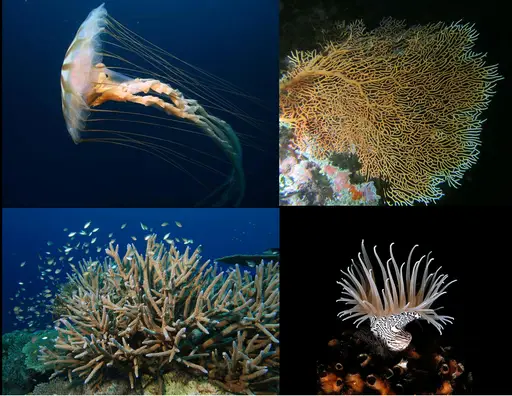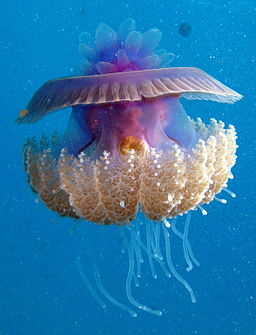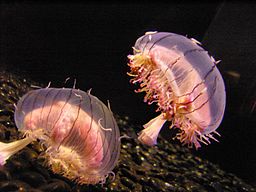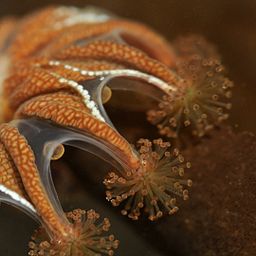Phylum Cnidaria
** Examples and Characteristics
Formerly known as Coelenterata (along with sea-combs), the phylum Cnidaria consists of over 11,000 species commonly found in marine habitats. They have a simple body plan consisting of two cellular layers; the ectoderm and endoderm.
With fossil records that can be traced back over 700 million years, the phylum is suggested to be one of the oldest groups of any metazoan.
It's divided into five main classes that include:
· Anthozoa (E.g. Sea anemones and hard corals)
· Scyphozoa (True jellyfishes)
· Hydrozoa (Hydras and Siphonophores)
· Cubozoa (Box jellyfish)
· Staurozoa (Stalked jellyfish)
* Another group known as myxozoa (consisting of microscopic endoparasites) is considered to be a class of the phylum Cnidaria in some books.
Phylum Cnidaria Characteristics
Anatomy/Morphology
Despite the diversity in their form, members of the phylum Cnidaria share a number of similar characteristics. For instance, as mentioned, they are all diploblastic. This means that their bodies are made up of two main germ layers which include the ectoderm and the endoderm. Whereas the ectoderm makes up the epidermis, the endoderm makes up the inner gastrodermis.
Here, however, it's worth noting that each of the germ layers consists of several basic types of cells that perform different functions. Some of the cells that can be found in the ectoderm include nerve cells, secretory cells (cells of the mucous glands), cnidocysts, interstitial cells, and epitheliomuscular cells.
Various cells that can be found in the endodermis include secretory cells (cells that secrete enzymes) and gastromuscular cells involved in food digestion among others.
The majority of these species also exhibit a symmetrical body plan (radial symmetry). This means that the body can be divided into two parts that are mirror images of each other. This is evident in jellyfish and sea anemones.
* Generally, members of the phylum Cnidaria are divided into two main categories based on their basic forms; polyps (tube-shaped organisms with a mouth surrounded by tentacles) and medusa (characterized by a bell-shaped/umbrella-shaped body with a mouth located at the center of the concave side. Their tentacles extend from the margin part of the body e.g. jellyfish).
* Whereas the tentacles of medusa species hang downward, those of polyps extend upwards.
* Some cnidarians go through polyps and medusa life stages.
Class Anthozoa
Anthozoa is the largest class within the phylum Cnidaria. Some of the most common members of this class include Sea pens, Sea Anemones, and Hard or Stony corals, Soft corals. With a tube-shaped morphology, these organisms are also known as polyps (with a hydroid form).
As mentioned, they are characterized by a tubular morphology. The mouth is located at one end, usually the upper part, where it's surrounded by tentacles. The lower part of the body, also known as the aboral end, is often attached to a surface/substratum by a structure known as a pedal disc.
The tentacles, which surround a slit-like mouth, contain specialized cells known as cnidocytes. These cells contain the organelles nematocytes (stingers). For this reason, cnidocytes are also known as stinging cells.
Although they have a digestive system, it's incomplete and only consists of the mouth, pharynx, and gastrovascular cavity. The pharynx is long (about two-thirds the length of the organism) and opens into the gastrovascular cavity. This cavity is divided into several chambers by septa known as mesenteries.
Because of their flower-like appearance, Anthozoans are also referred to as "flower animals". They greatly vary in size with some being about a meter in diameter. Their lifestyle also varies with some living in solitary while others live in a colony.
* Some Anthozoans have a skeleton-like structure for support.
* Anthozoans do not have a medusa stage.
* Anthozoans like sea anemones are brightly colored with a diameter of between 1.8 to 10 cm.
Class Scyphozoa
Class Scyphozoa of the phylum Cnidaria consists of about 200 species of jellies (larger jellyfishes/cup animals e.g. cyanea). Unlike Anthozoans, Scyphozoa have polyp and medusa life stages with the medusa phase being the most prominent (a bell-like morphology).
The majority of species in this class of phylum Cnidaria range from 2 to 40 cm in length. However, some, like Cyanea capillata can grow to 2 meters in diameter with even longer tentacles. The mouth is located on the underside where it's surrounded by tentacles.
Like most other cnidarians, the tentacles of these animals bear nematocysts which makes it easier to capture prey. The mouth part is connected to the gastrovascular cavity which is divided into four diverticuli (interconnected sac) in some of the species.
Though Scyphozoa species are generally characterized by a bell-shaped morphology, there is a variation in shape between different species. While some of the species have a shallow saucer-shaped body, others have a helmet-shaped appearance.
In most species, the body margins appear scalloped with the notches bearing a rhopalium and lappets. The length of tentacles also greatly varies between different species. In Aurelia, for instance, the marginal tentacles are generally few in numbers and shorter. In Cyanea, on the other hand, they are typically longer.
* Because of their ability to swim, members of this class tend to have a solitary lifestyle.
* Color varies from orange to pink.
* During the polyp stage, Scyphozoa have a tubular body. The mouth and tentacles are located on the upper part of the body while the lower part of the body may be attached to a substratum.
Class Hydrozoa
The class Hydrozoa of the phylum Cnidaria consists of over 3,700 species most of which polymorphs (exhibit both the polypoid and medusoid life stages). However, some of the species like freshwater hydras do not have the medusa state in their lifecycle.
As is the case with the other polyps, the polypoid hydrozoa have a cylindrical/tubular morphology. The mouth part is located on the upper part of the body (the oral end) where it's surrounded by tentacles. the mouth is connected to the gastrovascular cavity which is lined by the gastrodermis.
Hydrozoans like hydra are generally small in size, ranging from 25 to 30 mm in length. The slender stalk is attached to a substratum at the basal disc. The basal disc has glandular cells that allow these animals to adhere to given surfaces. In some of the polyps, reproductive organs (ovaries and testes) are present and look like rounded projections.
For the species that have a medusa stage, morphological changes are observed. In the case of hydroid medusae, bell-shaped individuals are common. They are small in shape, ranging from 2mm to several centimeters in diameter. The body resembles a helmet with tentacles extending from the margins. Here, however, the general morphology also varies between the species.
Class Cubozoa
The class Cubozoa of the phylum Cnidaria is a smaller group with about 50 known species. As the name suggests, members of this group have a box-shaped medusa (square-shaped bell morphology). For this reason, members of this group are often referred to as box jellyfish.
Like some of the other cnidarians, cubozoans are of average size, ranging from 15 to 25 centimeters in diameter. While they exist in polypoid form, this has been shown to be inconspicuous. The medusa form, on the other hand, is predominant with higher mobility.
Cubozoans share a number of morphological characteristics with members of the class Scyphozoa. However, unlike schyphozoans, cubozoans possess muscular pads known as pedalia at each corner of their box-shaped bell/umbrella margin. At each of these corners, the pedalia bear one or more tentacles.
Nemocytes, used to capture prey, are arranged in a spiral manner along the tentacles in some of these organisms. Like other jellyfish, the mouth of cubozoans is located on the concave side of the animal. This mouth is connected to the digestive system which may extend into the pedalia in some species.
Some of the other organs/structures that can be observed at the concave side of the umbrella include the gastric pouch, Rhopalium, and gonad.
* The subumbrella edge of cubozoans turns inward forming a velarium which acts like the velum found in Hydrozoans.
* Cubozoans were formerly classified under the class Scyphozoa.
Class Staurozoa
The class Staurozoa of the phylum Cnidaria consists of more than 50 species. It's a relatively new class with small organisms that measure between 1 and 4 centimeters in diameter. Also known as stalked jellyfishes (stauromedusae), Staurozoans are polyp-like medusae that spend their lives attached to substratum like algae by means of peduncle.
Like jellyfish, however, their body consists of an umbrella part and tentacles that bear cnidocysts.
The umbrella part, which makes up the main body part also known as the calyx, typically draws out into eight simple or four bifurcated arms from which short tentacles emerge. For this reason, the majority of species have a trumpet-like body morphology (or goblet form). The mouth part of the organism is located in the calyx and is often raised.
Compared to the mouth of other jellyfish, the mouth of Staurozoans is characterized by four distinctive corners. At the four corners of the mouth, there are four funnel-like depressions known as infundibula (with longitudinal muscle that run down to the stalk).
The eight primary tentacles produced during the development of juveniles give rise to another set of tentacles known as secondary tentacles. In some of the species, the primary tentacles are lost or modified into anchors (hollow structures with adhesive qualities). However, in most of the species, these tentacles are retained.
* On the calyx, the majority of Staurozoans display distinctive patterns where nematocysts are located.
* Their colors often resemble the color of the algae on which they are attached.
Class Myxozoa
Myxozoa is a fairly recent group of the phylum Cnidaria that consists of microscopic organisms. Unlike other cnidarians, members of this group are obligate endoparasites and thus survive by benefiting from various aquatic vertebrates and invertebrates.
Initially, Myxozoans (also known as Endocnidozoa) were considered protists. However, based on recent molecular studies, they have been shown to cnidarians. Like medusozoans, the majority of myxozoans are freshwater organisms.
* Currently, myxozoans are said to make up about 20 percent of all cnidarians. Though the majority of species are found in freshwater, they are capable of infecting marine and terrestrial hosts.
Some examples of myxozoans include:
· Chloromyxum
· Kudoa
· Myxidium
· Henneguya Myxobolus
· Cystodiscus
Distribution/Habitat
The majority of the phylum Cnidaria are found in shallow marine habitats in tropical areas. However, a few species can be found in lagoons, estuarine and a few other freshwater habitats. All freshwater species belong to the subphylum Medusozoa.
Hydra, which is the most popular organism in this group, can be found throughout the world except for Antarctica. It's commonly found residing on the underside of aquatic leaves and lily pads in the clean water of pools and streams.
Members of the class Schyphozoa are commonly found in marine habitats. Here, the majority of species can be found freely floating in the open sea. However, there is at least one species that lives its life attached to seaweeds among other substrata at the bottom of the sea (this is referred to as a sessile species).
Like Schyphozoans, members of the class Cubozoa are also marine organisms. With the medusa being the predominant form (cubomedusae), they can be found swimming to catch prey. Polyps, while not as common, remain attached to substratum with limited mobility.
All Anthozoa species are marine polyps. As such, they have limited movement and can be found attached to substrates in polar and tropical seas (both in shallow water and deep-sea).
* Apart from hydrozoans, which belong to the subphyla Medusozoa, the other classes belong to the subphyla Anthozoaria and are generally considered marine organisms.
Adaptations
Over the course of their lives, the majority of cnidarians alternate between two body forms; the free-swimming medusa (e.g. jellyfish) and the polyp (e.g. Coral) which tends to be immotile/sessile. However, while the majority of polyps (e.g. hydra) do not transform into medusae, the majority of medusae (jellies) have a polyp stage.
Despite their differences, those in the phylum Cnidaria have a number of adaptations that allow them to survive in their respective habitats. According to studies, many of these species have also been shown to form a symbiotic relationship with photosynthesizing organisms like dinoflagellates (intracellular dinoflagellates).
From this relationship, they have easy access to the food manufactured by these organisms (extra source of food). Apart from food material obtained from dinoflagellates, cnidarians are also well equipped to capture prey in their surroundings.
As mentioned, all species poses stinging structures known as nematocysts (cnidae) in their tentacles. When triggered, these highly tubular-like structures can fire within a fraction of a second to stick to or wrap around prey. This action injects poison into the prey making it easier to capture and consume it.
For sessile species, studies have shown them to attach to various surfaces (substratum) by producing/secrete a complex glue-like substance at the pedal disc. This allows them to remain in place in areas where they have easy access to prey. Although they do not have the high motility of free-swimming species, polyps can detach from the substratum in various ways.
While smaller polyps can produce bubbles that allow them to detach and float, relatively larger species can extend their stalk and tentacles and bend from side to side. As well, cnidarians like hydra can move from one point to another through a process known as loping.
Here, the organism first bends so that the tentacles can be fixed and attached to the substratum (this attachment is made possible by the glutinant nematocsts). Once the tentacles attach to the substratum, the basal disc separates/detaches from the substratum allowing the organism to move in a manner known as somersaulting.
For free swimmers like jellyfish, locomotion is made possible by the dome-shaped (bell-shaped) tissue. Here, the process involves the contracting and relaxation of a ring of muscles located around this bell/umbrella. With this contraction and relaxation, water is allowed in and then forced out pushing the organism forward.
* Hydra can also move along the substratum by gliding. This is made possible by the pseudopodial action of the basal disc cells.
Reproduction/Lifecycle
The majority of cnidarians (those with polyp and medusa stages) can reproduce sexually and asexually. However, the free-swimming medusa species are only capable of sexual reproduction. Typically, it's polyps that reproduce asexually.
One of the most common modes of asexual reproduction is budding. In this type of reproduction, a small bud develops from the parent organism and eventually breaks off. Depending on the species, this may only produce another polyp or both a polyp and medusa. Unlike the polyps, medusae have temporary reproductive organs that allow for sexual reproduction.
During reproduction, gametes are released into the water for external fertilization to occur. Following fertilization, the zygote develops into a larva which settles on a substrate and develops into adult polyps allowing the cycle to continue.
General Morphology of Polyps and Medusa
* In some species (e.g. sea anemones), asexual reproduction involves a type of fission known as pedal laceration.
* In microscopic cnidarians, asexual reproduction involves multiple fission and requires two host organisms to complete the cycle.
Nervous system - Most of the phylum Cnidaria have a simple/primitive nervous system that is scattered across the body (a nerve net). It largely consists of a group of cells (nerve cords at the base of the epidermis and base of the gastrodermis) with a mixture of motor and sensory neurons
Digestive system - Cnidarians have an incomplete digestive system where the gastrovascular cavity serves as both the mouth and the anus. Captured prey is first drawn into the gastrovascular cavity where enzymes are discharged to break down the food particles (digestion is extracellular).
Once the enzymes break down the food particles, the cells lining the gastrovascular cavity absorb the nutrients. Undigested material and waste products are then transported back to the gastrovascular cavity to be expelled through the mouth.
See also: Phylum Ctenophora
What does Phylum mean in Biology?
Return from Phylum Cnidaria to MicroscopeMaster home
References
Carolina J. Zagal. (2009). Scyphozoa & Staurozoa -Jellyfish
Marı´a Irene Deserti, Priscila A. Grohmann, and Se´ rgio N. Stampar. (2020). Phylum Cnidaria.
The McGraw−Hill Companies. (2002). Radiate Animals Cnidarians and Ctenophores.
Thomas Jankowski and Boris Anokhin. (2019). Phylum Cnidaria.
Links
https://sciencing.com/basic-characteristics-cnidaria-8399110.html
https://www.notesonzoology.com/marine-animals/locomotion-in-hydra-with-diagrams-marine-animals/1881
Find out how to advertise on MicroscopeMaster!








